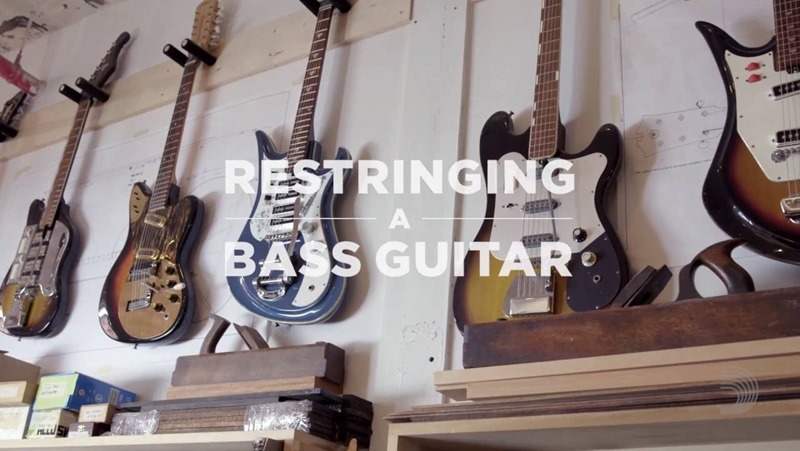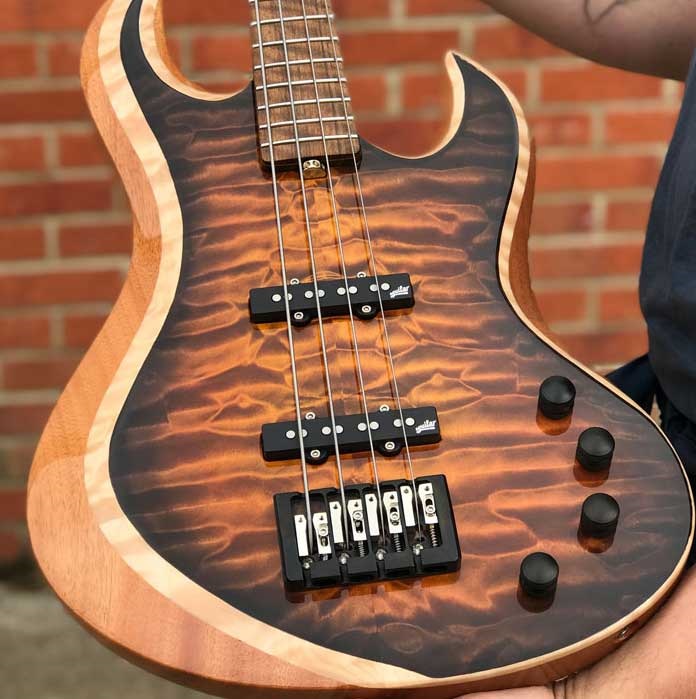You would be surprised at how many bassists – even for ones that build basses – don’t always install strings correctly.
It is common that many new bass players aren’t aware that on a slotted tuner (which accounts for most bass tuners,) you’re supposed to insert string straight down the center hole for use as an anchor, then wrap.
The particular bit of information that will prove most useful (and this is something we’ve written here before) is measuring how much string to use before clipping so you get enough string for the center hole insert, and so you don’t get unnecessary over-wrap.
Generally speaking, you measure how much string to clip off using the “two tuner” method shown in the video or the “two fret” method (pull string through tuner slot up to tension, then pull string two frets back, then clip of excess after the tuner.)
Watch the video below by D’Addario to see how it’s done.




The strings should also be bottomed out on the posts in order to achieve a good break angle & down pressure on the nut. It looks better & neater too.
Aren’t you supposed to bend the string at a right angle before making a cut?
Actually, I use the entire string because the more wraps around the A and E helps get a good downward pressure over the nut.
I was taught NEVER to remove all the strings off of any stringed instrument, one at a time is best unless you are slack in the truss rod.
That’s what I always do, Artie.
Another thought, this is a good time to make the strings “break” at the saddles.
I’ve seen that, too – might have been here.
I like to check the ball end before it is tight against the saddle to ensure that the string hasn’t twisted over as it is tightened by the tuner, by sliding my two fingers along the string from the nut to the bridge, Usually you will see the ball end rotate slightly as you do this.
William Voight my point exactly. If you skip this step you can’t even see how badly you twisted your strings lengthwise. Nobody ever mentions this in any tutorial video.
Absolutely agree with William and Bert. Having strings tightened with a twisted core, and others that are not makes a world of difference to how they vibrate.
The way I learned this many moons back was the day I tried everything to work out why my A string was fret buzzing when the previous string didnt, and none of the other strings did either.
I thought that it must just be a bad string. Eventually I took it right off and put it back on taking care to make sure that everything was perfect. Suddenly, no fret rattle as the string sustained after plucking. I actually didnt realise the cause at the time and scratched my head until I was talking with a guitar tech at a gig and he laughed at me and explained about the twisting.
I concur – I’ve noticed that if I use more windings so the string sits at the bottom of the tuner, I get better downward pressure on the nut and less rattle on an open strings (although my bass has a short 2+2 headstock with no string tree). This usually takes me a couple of tries to get the length right unless I just match the length of the old string. This has not led to tuning problems like I had heard, although I stretch them like the video, along with tuning up a bit higher, playing for a bit, then loosening and retuning up to standard pitch.
I like cleaning and conditioning the fretboard once the strings are removed.
As william stated, it is very important that the string is not twisted as this will greatly reduce the life of the string. It’s pretty easy to do, especially with string through body bridges
What about flatwounds? Cutting them can be problematic.
I cut my strings at 3 tuners, not 2. It gives a good neat wrap without overloading the peg
I always give the instrument a thorough clean once the old strings are removed; bridge, saddles, pickups, fretboard, headstock; everything I can’t really get at whilst the strings are in place.